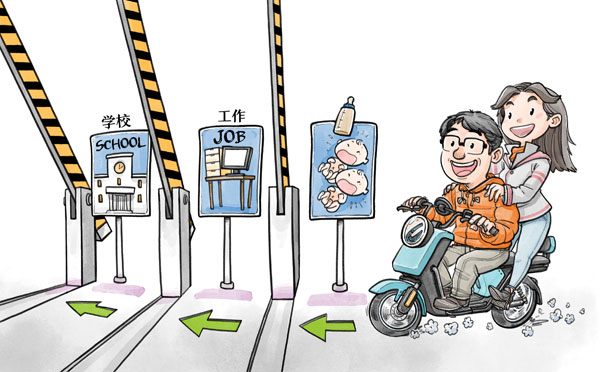Encourage childbearing for a better future
China Daily | Updated: 2018-11-26 07:43

Editor's note: Some demographers have advocated that more policies be introduced to reverse the low birth rate. Has China indeed reached the stage where fertility needs to be boosted? And how should China deal with the aging population? Three experts share their views on the issues with China Daily's Liu Jianna. Excerpts follow:
Need to raise fertility rate
Li Jianmin, a professor at the Institute of Population and Development, Nankai University
To address the population issue as a whole, we should take into consideration references as well as the absolute numbers. Some argue China has a large population irrespective of its vast geographical territory. Yet compared with countries such as Japan and the Republic of Korea, China's population density is low.
For decades, China has maintained a relatively low annual population growth rate. In fact, it could experience negative growth as early as in 2027, or 2026, if the fertility rate is not boosted.
The shrinking population growth rate and population structure problems-mainly manifested in the growing number of senior citizens and rising dependency ratio-together pose a grave threat to China's overall economic and social development.
That's why some experts have advocated that the population structure be adjusted. Yet given that China cannot possibly add to the workforce on a large scale through immigration as Germany and France did in the past decades, boosting the fertility rate is the only way to increase the newborn population and improve the population structure.
Chinese couples' declining desire to have children-the birth rate has fallen to about 1.7 children per couple-is quite dangerous. But many Chinese couples want to have just one child, or none at all, because of the soaring economic and social cost of childbearing. To solve this problem, the authorities have to take measures to increase people's household income and significantly lower the cost of raising children.
Avoid focusing only on population size
Ge Daoshun, a research fellow at the National Institute of Social Development, Chinese Academy of Social Sciences
Given the current dynamics in China's population scale, its total population is expected to gradually decline after reaching a peak of 1.5 billion or 1.6 billion. Contrary to most arguments, it is unnecessary to make the total population a big issue, as it requires much more than a large population to make a country a major power.
Nonetheless, the government should try its best to encourage childbearing to adjust the population structure, so as to better deal with the aging population issue. To begin with, the typical "4-2-1" (four grandparents, two parents and one child) family structure, a byproduct of the strict family planning policy in the past decades, has further twisted the population structure and increased the ratio of senior citizens in the total population.
Also, despite the advancements made in science and technology, including those in the artificial intelligence and robotics, robots cannot replace human workers in all the industries including the service sector. Which means the need for human workers will remain.
So a basic State policy to encourage couples to have two children should be introduced. But still, China's population decline after peaking at 1.5 billion or 1.6 billion can only be slowed, not reversed.
More important, the threat of an aging population should not be overestimated as the aging rate remains low nationwide. Besides, the implications of an aging population are quite different today from what they were decades ago. In the past, people above 60 needed a lot of care, but today people in their 60s, even 70s, in general, can take care of themselves.
Also, pilot projects for long-term care insurance have been launched in cities such as Shanghai, and Qingdao, Shandong province, and they are expected to play an important role in improving the lives of senior citizens suffering illnesses.
As long as the eldercare policies are well designed and eldercare resources effectively used, China will be able to handle the aging population issue.
Aging population not a big problem
Mu Guangzong, a professor at the Institute of Population Research, Peking University
The low birth rate and growing imbalance in the population structure pose substantial risks to socio-economic development. The population size is only a part of the population issue; the crux lies in the structure and function of the population. Realizing a moderately low birth rate and orderly population movement is the key to improve and optimize the age structure of China's population under open conditions.
China entered an era of low birth rate in the early 1990s, which is not conducive to sustainable population growth and the overall harmonious development of society. Now that having one child has more or less become the norm for couples, the government should build a family and childbearing-friendly environment to help raise the birth rate.
Also, besides promoting healthy aging and active aging among senior citizens, China should also devise a strategy for harmonious and moderate aging with Chinese characteristics. Harmonious aging stresses the harmony between body and mind, and humans and nature, while moderate aging emphasizes the internal coordination and balanced development in the population's age structure.
The fact that senior citizens can continue to contribute to society should also be promoted. As the builders of Chinese society, senior citizens have gathered much valuable experience, which should be put to fruitful use.























